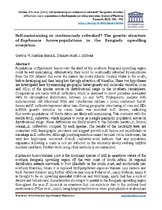| dc.contributor.author | Harkins, Gordon William | |
| dc.contributor.author | D'Amato, Maria Eugenia | |
| dc.contributor.author | Gibbons, Mark J. | |
| dc.date.accessioned | 2017-10-19T08:57:02Z | |
| dc.date.available | 2017-10-19T08:57:02Z | |
| dc.date.issued | 2013 | |
| dc.identifier.citation | Harkins, G.W. et al. (2013). Self-maintaining or continuously refreshed? The genetic structure of Euphasia lucens populations in the Benguela upwelling ecosystem. Journal of Plankton Research, 35(5): 982 – 992 | en_US |
| dc.identifier.issn | 0142-7873 | |
| dc.identifier.uri | http://dx.doi.org/10.1093/plankt/fbt046 | |
| dc.identifier.uri | http://hdl.handle.net/10566/3241 | |
| dc.description.abstract | Populations of Euphausia lucens over the shelf of the southern Benguela upwelling region could be self-maintaining. Alternatively, they could be continually refreshed by expatriates from the SW Atlantic that enter the system via South Atlantic Central Water in the south, before developing and then being lost through advection off Namibia. These two hypotheses are investigated here by examining geographic heterogeneity and molecular variation (cox1 and ND1) of the species across its distributional range in the Southern Hemisphere. Comparisons are made with E. vallentini, which is assumed to show panmixia associated with its circumglobal distribution between 50 and 60°S. Phylogenetic analysis with mitochondrial 16S ribosomal RNA and cytochrome oxidase 1 (cox1) confirmed that E. lucens and E. vallentinirepresent sister taxa. Strong geographic structuring of cox1 and ND1 mtDNA genetic variation by ocean basin was recorded in E. lucens, indicating that neritic populations off South Africa are likely self-maintaining. This contrasts with the results for E. vallentini, which appears to occur as a single panmictic population across its distributional range. These differences are likely related to the habitats (neritic, E. lucens; oceanic, E. vallentini) occupied by each species. The results of the neutrality tests are consistent with demographic processes and suggest growth in E. lucens and equilibrium or shrinkage in E. vallentini. Although purifying selection cannot be ruled out in the former, the very few haplotypes recovered from E. vallentini could indicate that any population expansion following a crash is not yet reflected in the relatively slowly evolving mtDNA markers used here. Further work using other methods is recommended. | en_US |
| dc.language.iso | en | en_US |
| dc.publisher | Oxford University Press | en_US |
| dc.rights | This is the author-version of the article published online at: http://dx.doi.org/10.1093/plankt/fbt046 | |
| dc.subject | Krill | en_US |
| dc.subject | Connectivity | en_US |
| dc.subject | Phylogeography | en_US |
| dc.subject | Southern hemisphere | en_US |
| dc.subject | Oceanic | en_US |
| dc.subject | Neritic | en_US |
| dc.subject | Species designation | en_US |
| dc.title | Self-maintaining or continuously refreshed? The genetic structure of Euphausia lucens populations in the Benguela upwelling ecosystem | en_US |
| dc.type | Article | en_US |
| dc.privacy.showsubmitter | FALSE | |
| dc.status.ispeerreviewed | TRUE | |
| dc.description.accreditation | Web of Science | |

